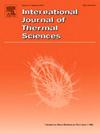Using deep learning algorithm to predict flow boiling pressure drop under ultrasound fields in mini-channels
IF 4.9
2区 工程技术
Q1 ENGINEERING, MECHANICAL
International Journal of Thermal Sciences
Pub Date : 2025-05-26
DOI:10.1016/j.ijthermalsci.2025.110023
引用次数: 0
Abstract
Ultrasound is widely acknowledged as an effective method for enhancing active heat transfer, thereby significantly augmenting the heat dissipation capacity of mini/micro-channels. However, there is lack of accurate methods for predicting two-phase pressure drop under ultrasound field. The study proposes a novel deep learning-based approach, namely the Multi-Scale Convolutional Neural Network (MSCNN) combined with Time-Frequency Representation (TFR), for predicting flow boiling pressure drop in mini-channels under ultrasound field. Time-series pressure drop fluctuation data of gas-liquid two-phase were transformed into useful TFRs data by wavelet transform. TFR could effectively reveal the pressure drop fluctuation of gas-liquid two-phase in mini-channel under ultrasound field, but the TFRs data scale was the high dimensionality and consumes computer resources. Therefore, bilinear interpolation was used to reduce TFRs data scale and as input of deep learning model. Compared with the traditional convolutional neural network (CNN) model structure, MSCNN model structure has global and local information synchronization. The prominent features are helpful to predict flow boiling pressure drop in mini-channel under ultrasound field and to the automatic learning of MSCNN. Experiments showed that the prediction performance of MSCNN model has been greatly improved than the traditional data-driven.
利用深度学习算法预测超声场作用下微通道内流动沸腾压降
超声被广泛认为是一种有效的增强主动传热的方法,从而显着增加了迷你/微通道的散热能力。然而,目前还缺乏准确预测超声场下两相压降的方法。本研究提出了一种基于深度学习的多尺度卷积神经网络(MSCNN)与时频表示(TFR)相结合的方法来预测超声场下微通道内流动沸腾压降。采用小波变换将气液两相压降波动时间序列数据转化为有用的TFRs数据。TFR能有效地揭示超声场作用下微通道内气液两相压降波动,但TFR数据规模高维且消耗计算机资源。因此,采用双线性插值来减小tfr数据规模,并作为深度学习模型的输入。与传统卷积神经网络(CNN)模型结构相比,MSCNN模型结构具有全局和局部信息同步的特点。这些显著的特征有助于超声场作用下小通道内流动沸腾压降的预测和MSCNN的自动学习。实验表明,与传统的数据驱动模型相比,MSCNN模型的预测性能有了很大的提高。
本文章由计算机程序翻译,如有差异,请以英文原文为准。
求助全文
约1分钟内获得全文
求助全文
来源期刊

International Journal of Thermal Sciences
工程技术-工程:机械
CiteScore
8.10
自引率
11.10%
发文量
531
审稿时长
55 days
期刊介绍:
The International Journal of Thermal Sciences is a journal devoted to the publication of fundamental studies on the physics of transfer processes in general, with an emphasis on thermal aspects and also applied research on various processes, energy systems and the environment. Articles are published in English and French, and are subject to peer review.
The fundamental subjects considered within the scope of the journal are:
* Heat and relevant mass transfer at all scales (nano, micro and macro) and in all types of material (heterogeneous, composites, biological,...) and fluid flow
* Forced, natural or mixed convection in reactive or non-reactive media
* Single or multi–phase fluid flow with or without phase change
* Near–and far–field radiative heat transfer
* Combined modes of heat transfer in complex systems (for example, plasmas, biological, geological,...)
* Multiscale modelling
The applied research topics include:
* Heat exchangers, heat pipes, cooling processes
* Transport phenomena taking place in industrial processes (chemical, food and agricultural, metallurgical, space and aeronautical, automobile industries)
* Nano–and micro–technology for energy, space, biosystems and devices
* Heat transport analysis in advanced systems
* Impact of energy–related processes on environment, and emerging energy systems
The study of thermophysical properties of materials and fluids, thermal measurement techniques, inverse methods, and the developments of experimental methods are within the scope of the International Journal of Thermal Sciences which also covers the modelling, and numerical methods applied to thermal transfer.
 求助内容:
求助内容: 应助结果提醒方式:
应助结果提醒方式:


